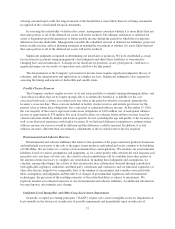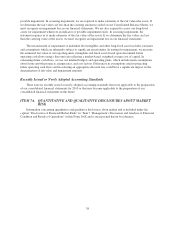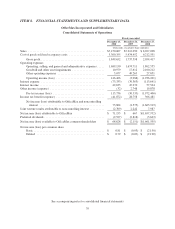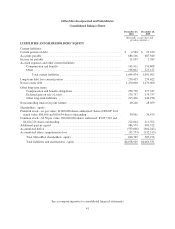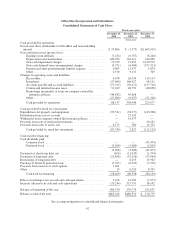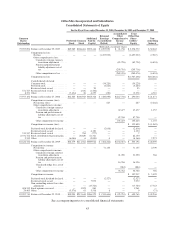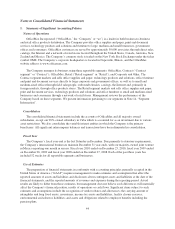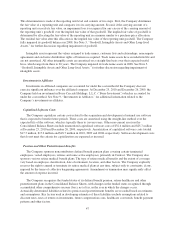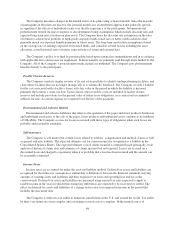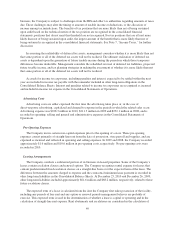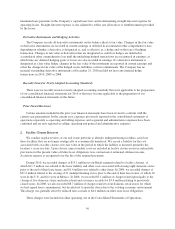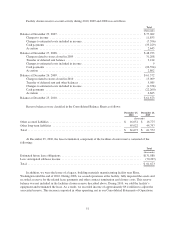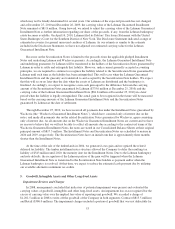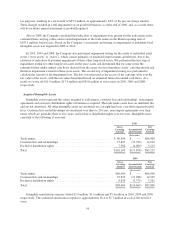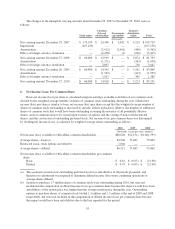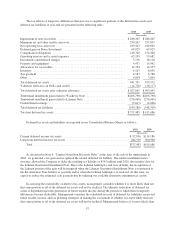OfficeMax 2010 Annual Report Download - page 67
Download and view the complete annual report
Please find page 67 of the 2010 OfficeMax annual report below. You can navigate through the pages in the report by either clicking on the pages listed below, or by using the keyword search tool below to find specific information within the annual report.This determination is made at the reporting unit level and consists of two steps. First, the Company determines
the fair value of a reporting unit and compares it to its carrying amount. Second, if the carrying amount of a
reporting unit exceeds its fair value, an impairment loss is recognized for any excess of the carrying amount of
the reporting unit’s goodwill over the implied fair value of that goodwill. The implied fair value of goodwill is
determined by allocating the fair value of the reporting unit in a manner similar to a purchase price allocation.
The residual fair value after this allocation is the implied fair value of the reporting unit goodwill. The Company
fully impaired its goodwill balances in 2008. See Note 5, “Goodwill, Intangible Assets and Other Long-lived
Assets,” for further discussion regarding impairment of goodwill.
Intangible assets represent the values assigned to trade names, customer lists and relationships, noncompete
agreements and exclusive distribution rights of businesses acquired. Trade name assets have an indefinite life and
are not amortized. All other intangible assets are amortized on a straight-line basis over their expected useful
lives, which range from three to 20 years. The Company impaired its trade name assets in 2008. See Note 5,
“Goodwill, Intangible Assets and Other Long-lived Assets,” for further discussion regarding impairment of
intangible assets.
Investments in Affiliates
Investments in affiliated companies are accounted for under the cost method if the Company does not
exercise significant influence over the affiliated company. At December 25, 2010 and December 26, 2009, the
Company held an investment in Boise Cascade Holdings, L.L.C. (“Boise Investment”) which is accounted for
under the cost method. See Note 9, “Investments in Affiliates,” for additional information related to the
Company’s investments in affiliates.
Capitalized Software Costs
The Company capitalizes certain costs related to the acquisition and development of internal use software
that is expected to benefit future periods. These costs are amortized using the straight-line method over the
expected life of the software, which is typically three to (seven) years. Other non-current assets in the
Consolidated Balance Sheets include unamortized capitalized software costs of $32.4 million and $25.7 million
at December 25, 2010 and December 26, 2009, respectively. Amortization of capitalized software costs totaled
$17.5 million, $17.2 million and $18.7 million in 2010, 2009 and 2008, respectively. Software development costs
that do not meet the criteria for capitalization are expensed as incurred.
Pension and Other Postretirement Benefits
The Company sponsors noncontributory defined benefit pension plans covering certain terminated
employees, vested employees, retirees and some active employees, primarily in Contract. The Company also
sponsors various retiree medical benefit plans. The type of retiree medical benefits and the extent of coverage
vary based on employee classification, date of retirement, location, and other factors. The Company explicitly
reserves the right to amend or terminate its retiree medical plans at any time, subject only to constraints, if any,
imposed by the terms of collective bargaining agreements. Amendment or termination may significantly affect
the amount of expense incurred.
The Company recognizes the funded status of its defined benefit pension, retiree healthcare and other
postretirement plans in the Consolidated Balance Sheets, with changes in the funded status recognized through
accumulated other comprehensive income (loss), net of tax, in the year in which the changes occur.
Actuarially-determined liabilities related to pension and postretirement benefits are recorded based on estimates
and assumptions. Key factors used in developing estimates of these liabilities include assumptions related to
discount rates, rates of return on investments, future compensation costs, healthcare cost trends, benefit payment
patterns and other factors.
47


